#the-ferris-state-austrian
Explore tagged Tumblr posts
Text
"Belgium" sounds like such a made-up country, when you think about it:
Three official state languages: Dutch, French and German
Houses the official seat for the continent's power bloc, of which it is a founding member
Once was the brutal colonizer of an African country about 80 times its own size
Monasteries have been brewing speciality beers for centuries
The area was ruled interchangeably by the Romans, the Franks, the Spanish, the Austrian-Hungarians, the French and the Dutch, before achieving independence after riots that were partially incensed by an opera
Invaded by the Germans... twice
Its people were spoken of favorably by Julius Caesar
Has sent 2 astronauts into space
Home to an international port, (in)famous for exports of both diamonds and drugs
Used to have a regular ferry to England
Offers boarding for international trains running both high-speed and nightly
Home to one of the "Venice of the North", just one of its many historical cities that are a hit with the photographically-inclined tourists
Another of its tourist traps is a remnant from the 1958 World Fair, an iron atom scaled up to 102 meter
Yet another tourist trap is a statue of a child taking a piss, which gets dressed up for special occasions
The country won the 1986 Eurovision song contest by entering the youngest candidate ever, a record that cannot be broken as long as current rules apply
Said contest winner has since appeared on The Masked Singer, as did Mr Eurovision himself, Johnny Logan, in a different season
Landscape transitions from the lowlands near the sea shore, over the marsh-like "polders" and fertile fields, into forested hills, all in a surface area of 30,528 km² (11,787 sq mi)
With this surface area, it still borders 4 countries, with numerous inclaves and exclaves
Its internal Regions also have exclaves
Its capital is officially bilingual
98% of the population is urban
This population numbers in the 11,5 million - given the lack of skyscrapers in Europe vs. the United States, that's a lot on a small surface area
It has a research station on Antarctica
I mean... We get it, Jean-Claude, your country's not like other countries, yeesh! Scale it down a bit, will you, it's becoming implausible.
15 notes
·
View notes
Text
Rescue workers tackled extreme weather on Monday in Slovenia, Austria and Croatia, with record floods, hundreds of landslides and at least seven deaths.
The storms have forced the evacuation of villages and caused major damage, with emergency crews braced to respond to landslides and potential dam bursts.
Flooding and lightning prove fatal
Most of the deaths recorded so far have been in Slovenia, where the extreme weather was reported to have killed at least six people by Monday.
They included two Dutch men believed to have been struck by lightning and four Slovenians thought to have been caught up in the flooding.
The natural disaster is the worst that Slovenia has seen since it gained independence in 1991. Prime Minister Robert Golob said the estimated damage ran at some €500 million ($548.3 million), and urged the European Union and NATO to provide help.
Experts say the conditions are partly fueled by climate change, which is linked to an increase in the frequency and intensity of extreme weather events.
Across the border in Austria, one woman was reported to have died after falling into the flooded Glan River in the southern village of Zollfeld.
The Austrian province of Carinthia had reported 80 major landslides by Sunday afternoon, while the neighboring province of Styria recorded 280 landslides by Sunday morning.
In Croatia, roads, fields, and settlements were flooded, with a state of emergency declared in various parts of the country.
Sandbags were used as makeshift dams to prevent major damage to residential buildings.
The situation was expected to ease in all three countries with authorities saying water levels were expected to drop on Monday.
Rainstorms wreak havoc further north
There was also stormy weather further north around the Baltic Sea region, resulting in airport delays, suspended ferries, and minor power outages.
Ferries between Poland and Sweden, from the German islands of Hiddensee and Rügen to mainland Germany, and from Norway to Denmark remained in harbor.
Police in the northeastern part of Denmark said on X, the platform formerly known as Twitter, that "the weather is still harsh."
Fire officials in the capital, Copenhagen, urged people to stay away from parks and forests, saying "the combination of rain-soaked ground and storms increases the risk of trees falling."
Norwegian authorities raised the extreme weather warning alert to its highest on Monday because of heavy rain, mudslides and flash floods.
In Latvia, wind gusts of up to 108 kilometers per hour (67 miles per hour) were reported to have knocked over trees.
Meteorologists also reported hail the size of golf balls in the village of Apgulde, southwest of the capital, Riga.
Polish authorities said thousands of homes in the country were affected by power cuts on Monday after storms and heavy rain over the weekend.
Some 7,500 homes had no electricity on Monday in the northeastern region of Podlaskie. In nearby Warmia-Masuria, that figure stood at some 5,000.
3 notes
·
View notes
Text

1958 Porsche 356 A Coupe
The Porsche 356A (T2) Speedster September 1957 to August 1958 (Carrerra Speedsters continued into 1959)
The last of the 356A Speedsters are probably the most attractive and the most desirable. The 356A (T2) Speedster was introduced in September 1957 and continued until the basic Speedster was replaced by the Convertible D in August 1958 although a number of Carrera, GS and GT Speedsters were produced in 1959.
History:
Ferdinand Porsche and the foundation of the Porsche Company
Ferdinand Porsche was born on September 3rd 1875, in the Bohemian village of Maffersdor. After attending grammar school and Staatsgewerbeschule (State Vocational School) in Reichenberg, he entered his father's metalworking business. The young and imaginative Ferdinand pursued a fascination with electricity working on the design of an electric car and in 1900 The Lohner-Porsche electric car is presented at the World Fair in Paris. Porsche's wheel hub engines brought the young engineer international attention. In the same year, he developed an all-wheel-drive racecar, as well as a hybrid petrol/electric vehicle.
In 1906 Ferdinand Porsche became Technical Director at Austro-Daimler in Wiener Neustadt. At the age of only 31, he became responsible for the model range of one of Europe's largest automotive concerns.
In September1909 Ferdinand's first son, Ferdinand Anton Ernst Porsche, later known as 'Ferry', was born. In 1910 The Austro-Daimler touring car designed by Ferdinand Porsche scores a triple victory in the Prince Henry Trials.
In 1923 as Technical Director and Board Member of the Daimler-Motoren-Gesellschaft in Stuttgart, Ferdinand Porsche was responsible for the design of the legendary Mercedes Compressor Sports Car and in the following year, he led the development of the 2-litre racecar won the Targa Florio. The Mercedes-Benz S-Type models dominate international motorsport from 1927.
Professor Ferdinand Porsche 1875-1951
In 1931 Ferdinand Porsche founded the company that bears his name "Dr. Ing. h. c. F. Porsche GmbH" to provide 'engineering and consultation on engine and vehicle design'. Based in Stuttgart the company carried out projects for manufacturers such as as Wanderer, Zündapp and NSU. In 1933 Porsche developed a Grand Prix mid-engined 16-cylinder racecar for Auto Union. He also developed a rear engined compact vehicle concept for NSU.
One year later the Porsche company received an official order for the design and construction of a German 'Peoples Car' or Volkswagen. The prototype was developed and assembled in the garage of the Porsche villa in Stuttgart and was road tested within 12 months At the same time production facilities were being set up for the Volkswagen which was officially called the 'KdF-Wagen'.
In December 1935 Ferdinand Alexander Porsche the first son of Ferry Porsche (and later known as 'Butzi') was born in Stuttgart.
During 1939 Porsche developed 3 racing coupés for long-distance endurance competition. These 'BerlinRome-Wagens' could be considered the forerunners of later Porsche sports cars.
He also designed the Mercedes T-80 in1939 to conquer the world land speed record. It was reputed to have a 3000 hp aircraft engine.
Because of the outbreak of the second world war Volkswagen production was diverted towards the military version of the Beetle, the Kübelwagen and Schwimmwagen. Only 1207 Volkswagen KdFs were built between 1941 and 1944
Porsche also designed several heavy tanks but did not get the production contract. Towards the end of the war the Porsche Engineering office moved to the relative safety of Gmünd in the Austrian province of Carinthia.
After the war the Volkswagen factory at Wolfsburg was taken over by the British and Ferdinand Porsche was arrested and imprisoned in France for 20 months.
In 1946 under the direction of Ferdinand Porsche's son Ferry, the Porsche Engineering office became involved in the design of an all-wheeldrive Grand Prix racecar for an Italian industrialist, Piero Dusio.
Ferry Porsche saw a market for a small, light two seater roadster and was unable to find a car in the market that matched his preference. He decided to build a car which became the first 356 and the first sportscar to bear the Porsche name.
4 notes
·
View notes
Text
Vienna: What to Do and See in the Green Heart of Europe

Plan Your Visit Today Click here
Nestled in the heart of Europe, Vienna is a city that effortlessly blends imperial grandeur with vibrant modernity. Renowned for its lush green spaces, rich history, and cultural treasures, the Austrian capital offers something for every traveler. Whether you’re a history buff, a music lover, or simply someone looking to soak in stunning landscapes, Vienna is a destination that delivers.
Explore Vienna’s Imperial Elegance
Start your journey with a visit to the iconic Schönbrunn Palace, a UNESCO World Heritage Site that once served as the summer residence of the Habsburg dynasty. Wander through its opulent rooms and beautifully manicured gardens, and don’t miss the panoramic views from the Gloriette.
Another must-see is the Hofburg Palace, located in the city center. This sprawling complex houses the Imperial Apartments, the Sisi Museum, and the Austrian National Library, each offering a glimpse into Vienna’s imperial past.
Immerse Yourself in Art and Culture
Vienna is synonymous with classical music, and no visit is complete without experiencing its musical heritage. Catch a performance at the Vienna State Opera or attend a concert featuring works by Mozart or Beethoven, both of whom lived and worked in the city.
youtube
Art enthusiasts will revel in the Kunsthistorisches Museum and the Belvedere Palace, home to Gustav Klimt’s masterpiece, The Kiss. The Albertina Museum is another highlight, boasting an extensive collection of graphic art and modern works.
Relax in Vienna’s Green Spaces
Known as the “Green Heart of Europe,” Vienna is dotted with parks and gardens perfect for unwinding. The Vienna Prater offers a mix of natural beauty and family-friendly fun, with its vast green meadows and iconic Ferris wheel.
For a more tranquil escape, visit the Stadtpark, famous for its golden Johann Strauss statue, or take a leisurely stroll through the Volksgarten, which bursts with vibrant roses in the spring and summer months.
Savor Viennese Cuisine
No trip to Vienna is complete without indulging in its culinary delights. Start your day with a traditional Viennese breakfast and treat yourself to a slice of Sachertorte at one of the city’s historic coffeehouses, such as Café Central. For a hearty meal, try Wiener Schnitzel paired with a crisp local white wine.
Discover Vienna’s Surrounding Vineyards
Just a short trip from the city center, Vienna’s lush vineyards offer an idyllic retreat. The Vienna Wine Hiking Trail provides scenic views and a chance to sample locally produced wines at traditional Heurigen (wine taverns).
Plan Your Visit Today
Vienna is more than just a destination; it’s an experience that stays with you long after you leave. From its rich history to its vibrant cultural scene and serene green spaces, the city promises a memorable adventure for every traveler.
Ready to explore the wonders of Vienna? Click here to start planning your trip with our exclusive travel packages and insider tips. Let us help you create an unforgettable journey to the Green Heart of Europe!
#Vienna Travel Guide#Things to Do in Vienna#Vienna Attractions#Green Heart of Europe#Schönbrunn Palace#Hofburg Palace#Vienna Music and Culture#Austrian Cuisine#Viennese Coffeehouses#Vienna Parks and Gardens#Vienna State Opera#Vienna Day Trips#Vienna Wine Hiking#European Destinations#Travel Tips for Vienna#Youtube
0 notes
Text
Events 12.2 (before 1950)
1244 – Pope Innocent IV arrives at Lyon for the First Council of Lyon. 1409 – The University of Leipzig opens. 1697 – St Paul's Cathedral, rebuilt to the design of Sir Christopher Wren following the Great Fire of London, is consecrated. 1763 – Dedication of the Touro Synagogue, in Newport, Rhode Island, the first synagogue in what will become the United States. 1766 – Swedish parliament approves the Swedish Freedom of the Press Act and implements it as a ground law, thus being first in the world with freedom of speech. 1804 – At Notre Dame Cathedral in Paris, Napoleon Bonaparte crowns himself Emperor of the French. 1805 – War of the Third Coalition: Battle of Austerlitz: French troops under Napoleon decisively defeat a joint Russo-Austrian force. 1823 – Monroe Doctrine: In a State of the Union message, U.S. President James Monroe proclaims American neutrality in future European conflicts, and warns European powers not to interfere in the Americas. 1845 – Manifest Destiny: In a State of the Union message, U.S. President James K. Polk proposes that the United States should aggressively expand into the West. 1848 – Franz Joseph I becomes Emperor of Austria. 1851 – French President Louis-Napoléon Bonaparte overthrows the Second Republic. 1852 – Louis-Napoléon Bonaparte becomes Emperor of the French as Napoleon III. 1859 – Origins of the American Civil War: Militant abolitionist leader John Brown is hanged for his October raid on Harpers Ferry, Virginia (now West Virginia). 1865 – Alabama ratifies the 13th Amendment to the U.S. Constitution, followed by North Carolina, then Georgia; U.S. slaves were legally free within two weeks. 1867 – At Tremont Temple in Boston, British author Charles Dickens gives his first public reading in the United States. 1899 – Philippine–American War: The Battle of Tirad Pass, known as the "Filipino Thermopylae", is fought. 1908 – Puyi becomes Emperor of China at the age of two. 1917 – World War I: Russia and the Central Powers sign an armistice at Brest-Litovsk, and peace talks leading to the Treaty of Brest-Litovsk begin. 1927 – Following 19 years of Ford Model T production, the Ford Motor Company unveils the Ford Model A as its new automobile. 1930 – Great Depression: In a State of the Union message, U.S. President Herbert Hoover proposes a $150 million public works program to help generate jobs and stimulate the economy. 1939 – New York City's LaGuardia Airport opens. 1942 – World War II: During the Manhattan Project, a team led by Enrico Fermi initiates the first artificial self-sustaining nuclear chain reaction. 1943 – World War II: A Luftwaffe bombing raid on the harbour of Bari, Italy, sinks numerous cargo and transport ships, including the American SS John Harvey, which is carrying a stockpile of mustard gas. 1947 – Jerusalem Riots of 1947: Arabs riot in Jerusalem in response to the United Nations Partition Plan for Palestine. 1949 – Convention for the Suppression of the Traffic in Persons and of the Exploitation of the Prostitution of Others is adopted.
0 notes
Video
vimeo
No Kangaroos in Austria? Let's Find Out in a Hyperlapse Chase Through Vienna! from Kirill Neiezhmakov on Vimeo.
In Search of the Elusive Austrian Kangaroo: a Hyperlapse Adventure to Vienna. Subscribe instagram.com/neiezhmakov All info which you want to know in the description below �
Join us on a thrilling hyperlapse adventure through the beautiful city of Vienna, Austria, as we explore some of its most iconic landmarks and attractions. In this video, we'll also try to uncover the mystery behind the popular meme "No kangaroos in Austria" and see if we can find any of these fascinating creatures roaming the streets of Vienna.
Timelapse & Edit by Kirill Neiezhmakov e-mail: [email protected] facebook.com/kirill.neiezhmakov instagram.com/neiezhmakov tiktok.com/@hyperlapsepro Youtube: youtu.be/nihoFPz_dRA
*Music:* Happy Classic Cellos and Violins
Equipment: Canon 60d, 70d, EOS R, Tokina 11-16 mm 2.8 Canon 70-200 mm 4L Canon 16-35 mm 2.8L Canon 24-70 mm 2.8L Manfrotto 190 carbon tripod Software: Adobe After Effects, Lightroom, LRTimelapse
Thanks to my friend Peter from @filmspektakel for showing me some nice places in Vienna
Our journey begins at the magnificent St. Stephen's Cathedral, a stunning Gothic masterpiece that has been a symbol of the city for over 700 years. There you can go to a breathtaking journey up the cathedral's spiral staircase to the top of the South Tower, where you'll enjoy panoramic views of the city and the surrounding countryside.
Then, we'll stroll along the Graben, a historic street in the heart of Vienna's Old Town. The Graben is home to many of Vienna's most famous shops, cafes, and restaurants, as well as several historic buildings and landmarks.
Next, we'll head to the Hofburg Palace, the former imperial palace of the Habsburg dynasty. We'll speed through the palace's grand courtyards and ornate halls, including the famous Spanish Riding School and the imperial apartments of Emperor Franz Joseph and Empress Elisabeth.
We'll then take a spin on the iconic Wiener Riesenrad, a giant Ferris wheel that has been a fixture of the Vienna skyline since 1897. From the top, you'll enjoy stunning views of the city and the surrounding countryside.
Next, we'll visit the beautiful Schonbrunn Palace, a magnificent Baroque-style palace that was once the summer residence of the Habsburg monarchs. We'll take you on a fast-paced tour of the palace's lavish gardens and regal interiors, including the stunning Great Gallery and the famous Rococo-style Hall of Mirrors.
We'll also visit the Kunsthistorisches Museum and Maria-Theresien-Platz, two of Vienna's most famous cultural landmarks. The Kunsthistorisches Museum is home to an impressive collection of art and artifacts from around the world. The museum's exhibits include ancient Egyptian and Greek artifacts, Renaissance and Baroque art, and many other treasures, while Maria-Theresien-Platz is a beautiful public square that features a stunning equestrian statue of Empress Maria Theresa.
The Vienna State Opera House is another of Vienna's most famous cultural landmarks. The building, which was completed in 1869, has hosted some of the world's most renowned opera and ballet performances. You can come through the grand entrance and take you on a behind-the-scenes tour of this magnificent venue.
The Karlskirche is a beautiful baroque-style church that was built in the early 18th century. We'll take you on a speedy tour of the church's stunning dome and intricate frescoes are a sight to behold. The church's interior included its ornate pulpit and altar.
One of our stops is the Albertina Museum, where we'll marvel at its vast collection of art, including works by famous names like Monet, Picasso, and Durer.
The Burgtheater, which was built in the 18th century, is one of the most famous theaters in the world with the grand halls, including the stunning Marble Hall and the ornate staircase.
The Danube Island, located in the middle of the Danube River, is a popular recreational area for locals and tourists alike. We'll speed past the island's sandy beaches, bike paths, and green spaces, giving you a taste of this unique urban oasis.
Finally, the Donauturm, a towering 252-meter-high tower, offers unparalleled views of Vienna and the surrounding countryside. We'll take you on a dizzying ride up to the tower's observation deck, where you'll enjoy stunning panoramic views of the city and beyond.
And throughout our journey, we'll be on the lookout for any signs of kangaroos. So, come along for the ride as we discover the hidden gems of Vienna, and perhaps even catch a glimpse of a kangaroo or two. Whether you're a history buff, a culture vulture, or simply looking for adventure, this hyperlapse video has something for everyone.
Don't forget to like, comment, and subscribe to our channel for more exciting timelapse travel videos from around the world. And if you've ever seen a kangaroo in Austria, be sure to let us know in the comments below!
0 notes
Text
Some crazy shit I’ve been apart of while visiting Europe
-Came out of the metro in Paris and walked right into a yellow jacket riot. Scary but remarkably controlled. Parisian police all carry MP5s and are in full riot gear
-Was interviewed, recorded, and put on the Norwegian news for being the first in line for a seasonal ferry that brings life back into the isolated community of Gryllefjord after 9.5 months of darkness
-Experienced the devastating heatwave in Chamonix that created a never seen before lake on the Mont Blanc glacier and is now contributing to the mass melt of the glacier
-Watched authorities rescue the sunken boat and the lost bodies in Hungary from the Danube River boat accident that killed over 25 Koreans
-Was apart of a crowd of over 1,500 people watching the astrological clock in Prague turn to the hour. The clock was first installed in 1410!!! and is still the same it was back then making it the oldest operating clock in the world!
-Met a couple from Hawaii when I was in Italy that the husband told me his wife was the first nurse at the hospital to see Amanda Eller, the yoga teacher who went missing in Maui after going on a hike but was later rescued. (This was big news for like a month in the US) Turns out she didn’t just get “lost” but in fact she was tripping hard on mushrooms and walked the other way into the woods on her own, unlike what all the news reports state about her going missing. Thus, her claim that it was a “spiritual experience” is probably true.. look it up.
-Got pulled over by two smoking hot Austrian female cops (like literally the Baywatch of cops) that ran out from BEHIND a building and WAVED my car and the car behind me off the road and told us to pay them money right then and there because them “having to do paperwork would not be in our best interest” and “speeding tickets in Colorado are way more expensive.” Corrupt? Yes. Btw we were NOT speeding, but there was no arguing with those scary hot babes ESPECIALLY when your German is garbage.
-While in Switzerland I got to witness on several occasions the running of the beautiful ladies (female cows) dressed up in ribbons and flower crowns, and cleaned and brushed to perfection, marching orderly down the street. The ladies marching from tip to tail in a line, never getting distracted by the mass of people that line the streets to cheer them on and marvel at them.
-Stumbled out of a park in Bavaria right into a traditional German concert where everyone was dressed in dirndls and lederhosen, including all the spectators.
-The first time I saw complete darkness on my trip after getting out of northern Scandinavia was in Copenhagen (although it was only for 4-5ish hours). I had complete daylight for almost a month and it shocked my body (eye blinders are LIFE). Nordic humans are remarkable and their countries are the best in Europe btw.
-Took over 30 ferries in Norway, traveling the entire country north to south.
-In the Czech Republic, I watched a woman defecate in front of me, wipe her ass with leaves, and then pass out on the bench adjacent from me in a park.
-In another park story this time in Copenhagen, I watched a pack of 13 dudes roll into a park, spread out, whip out their dicks and start peeing. After 30 seconds or so their pack leader gave out a long whistle and then all the bros zipped up their pants and joined him and rolled out of the park as fast as they came into the park.
-In Germany, anytime you get onto one of their highways, cars will blast past you in the left going as fast as their motors can possibly go and yes everyone drives German made vehicles like Audi, BMW, VW, Porsche, and Mercedes so they go fucking fast.
4 notes
·
View notes
Text
Helfert, “Joachim Murat”, Chapter 4, Part 6
Apologies again for taking so long. I always start dragging my feet when I approach the end of a story. The end is usually bad, and I don’t want to see people suffer...
In contrast to the disintegrating Neapolitan army, with heaps of stragglers constantly troubling the population along all the streets and roads, the imperial troops formed a firm stand in closed ranks, with military severity but at the same time with military decorum, and were welcomed everywhere by the inhabitants as liberators. In his pompous appeal from Rimini, Murat had summoned deputies from all the towns and territories of the peninsula to Rome on 8 May, where a national assembly was to decide on the fate and organisation of Italy. That was long over, and instead of the members of the Italian parliament, who had never been expected, the two beautiful Bohemian regiments of Argenteau and Devaur showed up on one of the following days, kindly received by the Romans, and immediately continued their march to the south.
FML Bianchi, now already united with Neipperg's corps, together about 22,000 men strong, moved into the Neapolitan area in four columns. In Aquila on May 12, Neipperg, who had a diplomatic mission in addition to his military one, received a letter from Prince Metternich instructing him to promise Joachim Murat an annual pension of 1,000,000 fl. if he voluntarily abdicated his throne; however, Neipperg should first discuss the matter with the commander-in-chief. The two generals agreed that they would not offer anything to their opponent, for his downfall was certain. That same day, Bianchi issued an appeal to the Neapolitans, proclaiming himself not an enemy but a liberator from the rule of a son of the revolution imposed on them by peace-disturbing France; he promised strict discipline of his troops, respect for the laws and institutions of the country.
"Murat's party is seriously ill; they are trying in vain to bring it back to strength," an eyewitness in Naples wrote on 11 May. On the following day, the queen held a review of the capital's civic guard; she appeared on horseback in Amazon garb with the colours of the guard; she had a graceful word for each of the higher officers; she delighted the ranks, which burst into tumultuous cheers.
But at the same time a British squadron appeared in the Gulf of Naples, whose commander, Captain Robert Campbell, threatened to blow the city into ruins if the forts were not surrendered without delay, along with the "Joachim" and the "Capri", the two new royal ships of the line, and the royal arsenals with everything in them. Abrupt horror replaced the enthusiasm that had scarcely been exhilarated. The Regent called a Council of State, which was also attended by General Colletta, who had just arrived from camp, and Prince Cariati, who had returned from Vienna. The result was, in spite of the grandiloquent proposal of some members to simply reject Sir Campbell's request, that Caroline sent Prince Cariati on board the "Tremendous", where he yielded to all the Commodore's demands, while the latter promised to refrain from any hostility against the capital, to grant the Queen and her family refuge on one of his ships in case of extreme necessity, and moreover to send one of her ministers to Sir Bellew, now Lord Ermouth, or to London, as she wished, to negotiate in the King's name.
The imperial commander-in-chief's proclamation from Aquila had already become known in the capital. The fugitives, runaways and wounded arriving daily in Naples, who could be seen everywhere in the streets, had spread the word and caused a general commotion. Already the Lazzaroni were beginning to stir, and the civic guard was hardly equal to the task of offering them resistance. In a hurry, Jérôme and Cardinal Fesch, Madame Mère and Princess Pauline left the city to embark for France. The Queen said a poignant farewell to her children, whom she had taken to safety in Gaëta. But no one could see what was going on inside her when, on the evening of the 15th, she drove through the streets of the city in a carriage drawn by six magnificent white horses, surrounded by a detachment of mounted national guards in shining hussar uniforms, blue and silver, greeting her on all sides with friendly grace.
On the same May 15, Prince Leopold arrived in Rome and from there sent a letter to Bianchi, expressing to him "his complete impatience" to meet him "at this important moment when the King, my father, will have to thank you for his restoration to the throne of Naples".
The imperial troops advanced ever closer to the kingdom's capital. In the night from the 16th to the 17th, the imperial and royal Major d'Aspre and a small force attacked the camp of the 4th Neapolitan Legion, about 4,000 men, near Mignano and crushed it so completely that by the next morning everything was out of hand and General Macdonald was only able to reach the road three miles further on at Teano without being able to collect the ruins of his corps. When the Queen heard of this blow, she exclaimed: "Macdonald has gone on the scene to bring down the curtain. - Macdonald est allé baisser la toile". After the accident at Mignano, the royal army numbered barely 9,000 men: 1,000 men from the guard on foot, 3,000 from the first legion, 1,200 from the second, about 1,100 from the fourth; then 2,500 horsemen from the guard and line together; there was nothing left of the third division of Lecchi. Carascosa, to whom the king now handed over the supreme command, still held the Volturno line. But on the 18th his vanguard, which had been drawn up at the junction of the roads leading from Rome and Bescara, was attacked by the Austrians and thrown back into the bridgehead of Capua; a few cannon shots fell from the latter on the imperials without doing much damage.
King Joachim had arrived in his capital on the evening of the 18th, accompanied only by four lancers. "Madame", he reportedly said to his wife, "it was not granted to me to die". All his courtiers and supporters in Naples hurried to the palace to show him their devotion, which never made him feel better than at this moment, but which could not change the desperate seriousness of the situation. On the 19th a royal proclamation was issued granting the Neapolitans the long-promised constitution. It was a long document of a hundred or more articles, issued on May 12, backdated by almost a month and a half, from Rimini on March 30. We need not dwell on its provisions, the common phrases of modern constitutionalism; it never became a deed, and it had not the slightest influence on the mood of the minds. At the same time, Murat decided to enter into negotiations with the advancing enemy. On the morning of the 19th, Bianchi was about to mount his horse to inspect the ancient stone arched bridge on the banks of Solipaca, which was to be repaired for the crossing of the Volturno, when the Austrian Consul General of Naples appeared at the outposts. In a country house belonging to the Patrician family of Lanza, three miles from Capua, the imperial commander-in-chief had set up his main quarters, where Gallo soon arrived in the name of Joachim. But Bianchi, who was assisted by Generals Neipperg and Starhemberg and Lord Burghersh, declared that he was not a diplomat but a soldier; that the conquest of the kingdom was as good as complete, that he would neither cease hostilities nor grant an armistice; that there was no longer a "King Joachim", that it could at most be a question of a military convention from which "Marshal Murat" must be excluded. Gallo and the Consul General withdrew, and the military operations continued; during the night of the 19th to the 20th, Starhemberg crossed the Volturno. Then, on May 20, at 8 o'clock in the morning, the generals Carascosa and Colletta appeared at Casa Lanza, where the conclusion of a military convention was discussed, while the imperial troops continued their march across the Volturno at Cancello and Castel-Volturno without interruption. At 4 o'clock in the afternoon the agreement was concluded, signed on the Austrian side by Count Neipperg and the Commander in Chief; Lord Burghersh had taken part in the negotiations without, however, signing his name on the document. There were 13 articles with 6 additional points. According to the first, Capua was to be surrendered the next day, Naples with all its citadels on May 23, and the fortified places of Scylla, Amantea, Reggio, etc., handed over to the allies; only Pescara, Ancona and Gaëta were not included in the convention, because Carascosa and Colletta claimed to be without authority over them. In the supplementary articles, at the request of the Neapolitan negotiators, the Emperor of Austria guaranteed all the provisions which King Ferdinand IV had undertaken to observe on the repossession of his continental territory.
That same evening, after he had learned the arrangements of Casa Lanza, Joachim Murat - thus and not otherwise we may only refer to him henceforth, although no express renunciation of the throne had been made on his part - departed quietly and with few companions, among them his nephew General Bonafour, all dressed as simple private citizens, from Naples, won the beach at Miliscola, near Puzzuoli, and had himself ferried to the small island of Nisita and thence to Ischia, from where, on one of the next days, a merchant ship hired by General Manhès was to take him to France.
Can I start crying already?
#napoleon#joachim murat#caroline murat#naples#italy1815#hundred days#bonaparte family leaving the sinking ship what a clan#metternich still trying to save murat#that's why I don't want to see soldiers in political positions
10 notes
·
View notes
Photo

On This Day in History October 4, 1883: The predecessor to the famous Orient Express, Express d'Orient starts service. The idea for a Paris to Constantinople (Instabul) came from Belgian Georges Nagelmackers who saw the need for better rail service in Europe after riding on a Pullman train while traveling in the United States. According to the website The Man in Seat 61: The Truth Behind the Legend of the Orient Express...:
Nagelmackers' flagship, the 'Express d'Orient', starts running, twice a week, Paris (Gare de l'Est) - Strasbourg-Munich-Vienna-Budapest-Bucharest-Giurgiu. At Giurgiu, passengers cross the Danube by ferry to Ruse in Bulgaria, where a second train would be waiting for the 7-hour journey to Varna on the Black Sea. An Austrian Lloyd steamer then connects for the 14-hour sea voyage to Constantinople (Istanbul).
The complete rail line connecting Paris to Constantinople (Istanbul) would be completed in June 1889. The train would be renamed the Orient Express in 1891. With the exception of the war years the original Orient Express would continue to operate until May 1977.
There would be other trains running under the Orient Express name until December 12, 2009 when that train made its last run and would be removed from European train timetables.
For Further Reading:
The Man in Seat 61: The Truth Behind the Legend of the Orient Express...
An Illustrated History of the Orient Express by Arjan Den Boer from the Atlas Obscura website dated February 15, 2016
#The Orient Express#Express d'Orient#Georges Nagelmackers#Railroad History#Transportation History#European History#On This Day in History#This Day in History#History Today#Today in History#History#Historia#Histoire#HistorySisco
12 notes
·
View notes
Text
New Zealand Tours: Plan your individual trip
book a trip to new zealandWith its extension of more than 12,500 square metres, Fjordland National Park is the largest in New Zealand - and it offers unique nature experiences. January, February and March are considered to be the warmest months and best time to travel, then it is high season in New Zealand and many travellers are on the road. July is considered the coldest month, in winter it rains more often.
During this time, travellers are requested to follow the instructions regarding hurricanes abroad. Rail transport in New Zealand is operated by both state and private companies. The largest New Zealand railway company isKiwi Rail. There are regular bus services throughout the city of Auckland. Trains from Transdev Auckland serve the city and suburbs, while ferries link the city centre, the north shore and the east, and serve the islands around Auckland.
Distances in New Zealand
Read more about campervan hire New Zealand here.
if you don't find the points you mentioned interesting, it's actually difficult everywhere.
These are the cheapest offers travellers have found on Tripadvisor in the last few weeks.
Violations of the import regulations will be relentlessly met with money- (usually at least 400,- NZ Dollar) and possiblyZealand has definitely got two new crass fans with us, we love this country! especially in the summer months there can be bush and forest fires and as a result of this the infrastructure in tourist areas can be impaired. The Crown Hotel is located just 13 minutes from the beach in Napier. Besides the view of the coast, the original listed building in which the hotel is housed is fascinating. With your partner you will enjoy the Art Deco style furnishings. The places were called Whataroa, Hari Hari, Ross, Ruatapo, Hokitika, Greymouth, Westport where we turned back inland to stay in St Arnaud. The prices are per person for a return trip with hotel stay. These are the cheapest offers that travellers have found on Tripadvisor in the last few weeks. erlebenbe-neuseeland.de is one of over 40 travel websites of erleben-fernreisen GmbH. Founded in 2005 by Mark Lindner and Johannes van Stephaudt with first trips to Thailand and New Zealand, we are now a team of approx.
New Zealand Travel - By train through New Zealand
and Munich, Swiss (LX) from Zurich and Austrian (OS) from Vienna via Hong Kong to Auckland. Air New Zealand (NZ) and Singapore Airlines (SQ) offer codeshare flights from Frankfurt/M., Düsseldorf, Munich and Zurich via Singapore to Auckland and Christchurch.

2 notes
·
View notes
Text
8 Best Places In Austria To Visit

Austria may be a beautiful country to explore and an area that’s such a lot quite it's the capital city, Vienna. Now, that’s not saying Vienna is bad (it’s amazing) but there really may be a shed load of other beautiful and picturesque spots to ascertain.
That’s why I wanted to point out you a number of my very favourite and best places in Austria to go to on your next trip. Perched within central Europe, Austria may be a relatively small country that’s pretty easy to urge to go to on a road trip.
Though don’t let its size put you off, it's numerously incredible and simply the simplest places in Austria to go to dotted all across the place. That being said, with numerous places to ascertain, it can be hard to prioritise on your trip. this is often why I wanted to share some cool spots I hope you’ll love. Take a glance, below, at a number of the simplest places in Austria to go to. 🇦🇹
1.) Vienna

Okay, so we can’t mention all the simplest places in Austria to go to without naming its capital city. And you recognize what, Vienna may be a stunner of an area to explore.
Over the years, we’ve visited Vienna quite a few times and love how chilled-out, historic and cool the town is. it's such a lot going for it. Once you arrive, confirm to go to the old centre, see Schonbrunn Palace and visit the State Opera for a show (which are reasonably priced). Afterwards, head over to the Museum Quarter and delve into all the treasures that the townhouses.
Though, if that doesn’t catch your eye, head out on a hotrod tour of Vienna itself. You’ll drive your very own dinky car all across the city… it’s such a lot of fun! Oh yeah, and for a Sunday afternoon treat, head out for a Buschenschank experience where you’ll be gorging on the simplest wines and snacks from the vineyards at Nussberg Hill itself. It may be a treat. For dinner, don’t forget to pop to Griechenbeisl, which is so yummy, Historically, people would sign the walls here, and to the present day, you'll still see the signatures of; Wagner, Beethoven and Mozart all across the ceilings. If you’re feeling extra adventurous, head to Gugumuck (in the outskirts of Vienna) for a six-course meal of Viennese escargot! Yep, a six-course meal made entirely of snails (including dessert). It certainly was an experience that I’m glad I attempted.
2.) Hallstatt

Often claims it’s the oldest village in Austria but I’m still not too sure how true that's. Now, one thing is sure though – Hallstatt is stunning! Filled to the brim with alpine lodges and tiny streets, Hallstatt is now a UNESCO World Heritage Site that’s been protected for generations to return.
Now, it is often a touch little bit of an attempt to urge to the town itself, especially because the railway station is across the opposite side of the lake.
That being said, you'll mount board a ferry and wander around the town for each day trip needless to say – just remember to not miss the last boat back. After arriving, wander through the small streets, unwind within the central square and just enjoy the sweetness of this one-of-a-kind place. Oh, and if you’re within the area, pop over to the nearby Dachstein Ice Caves, too.
They’re incredible to ascertain. Just be warned, there are like 600 steps to climb here, so it’s not for the faint-hearted.
3.) Hohenems

Perched right within the west of the country, Hohenemes is one among the simplest places in Austria to go to if you’re a love delving into the history of an area. Now, one spot you can’t miss is that the 12th-century castle of Altems which is great for a stroll around. Oh, and another place to ascertain is that the Stadtpfarrkirche or parish church that dates back almost 500 years.
There are numerous historic buildings that you’ll be spoilt for choice. Better still, Hohenems is surrounded by those dramatic Austrian mountains. This all means there are many opportunities to ski the slopes in winter or follow the paths within the warmer months of summer.
4.) Wachau

Wachau is one among those areas which may not immediately spring to mind when thinking of Austria, but it certainly should. Only around 90-minutes from Vienna, it’s a gorgeous area that’s filled to the brim with local vineyards, river trails and historic castles.
Once you arrive, head out on the Wachau World Heritage Trail and stop off at places like; Spitz, Joching and therefore the Holzapfel Vineyards for a tasty tipple or two. After all, you’ve earned it with all that walking! 😉 Also, for a tasty bite, pop into Gasthof Goldenes Schiff (in Spitz) for a standard Austrian lunch. We had to role ourselves out of here.
5.) Ehrwald

Perched within the gorgeous district of Reutte, Ehrwald is one among the simplest places in Austria to go to if you're keen on the outside.
Nestled right the border with Germany, it’s towered over by the incredible Zugspitze that’s considered to be Germany’s tallest mountain.
Once you’re here, confirm to go out on the many trails that criss-cross this region. Afterwards, pop into Holzerstubn for the simplest beef dumpling stew. It’s a correct heart-warming treat.
6.) Wildsee

Lake & Seefeld or me, Seefeld is up there together of the simplest places in Austria to go to regardless of the season or time of year. Once you’re here, confirm to go to the Church of St.
Oswald or the Seekirche or Lake Church on Lake Wildsee. you'll paddle and swim on Lake Wildsee within the summer months, which is ideal on those really hot days. If you fancy a hike in summer, take the paths up to Kaltwassersee and see the incredible views over the region. It’s stunning.
7.) Melk

Further down the Danube, about 60-minutes drive from Wachau, is that the stunning town of Melk that's great to explore. Once you’re here, spend a couple of hours exploring Melk Abbey and see the stunning interiors of this monastery that overlooks the entire region. Now, you can’t take pictures inside but trust me once I say it’s stunning.
8.) St. Gilgen

Nestled on the banks of Lake Wolfgangsee, St. Gilgen is one among the simplest places in Austria to go to when you’re within the north of the country. Once you’re here, confirm to require the steam train up the Schafberg Mountain, which is completely gorgeous. Now, you would possibly actually recognize the SchafbergBahn train if you’re something of a movie buff? It’s the very one that’s featured in ‘The Sound of Music’. If you're taking a ship trip on the lake you'll pass a palatial looking building, it had been once a private school for navy officers of the longer term. Though, being a completely landlocked country, I’m not sure how appropriate a navy was (or is)?!? 😉
For a tasty bite, hop into Gasthaus Gimsenwirt who serve some tasty roasted venison.
3 notes
·
View notes
Text
Coronavirus Travel Restrictions, Across the Globe https://nyti.ms/2Wdr0kk
CORONAVIRUS TRAVEL RESTRICTIONS, ACROSS THE GLOBE.... Nations across the world have imposed travel restrictions to curb the spread of the coronavirus. Here, the current list of countries limiting entry.
By Ernesto Londoño and Aimee Ortiz |
Published March 14, 2020 Updated March 15, 2020, 3:42 p.m. ET | New York Times | Posted March 15, 2020 |
Countries across the world have imposed travel restrictions to curb the spread of the coronavirus. This list, pulled from official government reports and the United States State Department, will be updated as new measures are announced.
AFRICA
KENYA 🇰🇪
On March 15, the Kenyan government announced the suspension of all travelers from countries that have reported Covid-19 cases. Only Kenyan citizens will be allowed into the country “with self quarantine or government-designated facility,” officials said on Twitter. The measure is in place for 30 days.
“All who arrived within the last 14 days must self quarantine,” officials added.
MOROCCO 🇲🇦
As of March 15, the Moroccan government has suspended all flights to Algeria, Belgium, China, France, Germany, Italy, the Netherlands, Portugal and Spain, as well as passenger ferry services. The government also shut down the land borders with Ceuta and Melilla, the autonomous Spanish territories on the coast of Morocco.
Travelers arriving in Morocco “will be asked to fill out a health questionnaire on arrival and may be subject to temperature and other screening,” according to officials.
AMERICA'S
ARGENTINA 🇦🇷
Starting March 17, Argentina is halting all flights from Europe and the United States for at least 30 days.
People arriving to Argentina from areas with a significant number of cases — including the United States, Europe, South Korea, Japan and Iran — will be required to go into quarantine for 14 days.
BRAZIL 🇧🇷
As of March 14, Brazil had not imposed travel restrictions. Its health ministry recommended that all passengers who arrive on international flights remain at home for at least seven days and seek medical help if they develop coronavirus symptoms.
CANADA 🍁
Canada has not banned the entry of any foreigners. But it has required that anyone arriving in Canada from Hubei Province in China, Italy or Iran “self-isolate and stay at home” for 14 days and contact public health authorities within 24 hours of arrival.
The government added that all other passengers returning from overseas consider self-isolating for 14 DAYS.
COLOMBIA 🇨🇴
The government announced on March 13 that it would shut down the seven border crossings along its border with Venezuela. Starting March 16, Colombia will bar entry to any foreigner who has been to Europe or Asia within the past 14 days. Colombians who return from affected areas will be subject to mandatory quarantine for 14 days.
EL SALVADOR
On March 11, El Salvador announced it would bar entry to all foreigners, except accredited diplomats and legal permanent residents.
GUATEMALA 🇬🇹
Effective March 16, Guatemala will bar the entry of citizens of the United States, Canada, South Korea, Italy, France, the United Kingdom, China and Iran.
MEXICO 🇲🇽
As of March 14, Mexico had not imposed any travel restrictions.
PERU 🇵🇪
Peru on March 12 announced it would halt all flights from Asia and Europe, but it did not specify when the measure would take effect.
UNITED STATES🇺🇲
On March 11 the United States barred the entry of all foreign nationals who had visited China, Iran and a group of European countries during the previous 14 days.
The ban applies to countries in the Schengen Area, which are Austria, Belgium, Czech Republic, Denmark, Estonia, Finland, France, Germany, Greece, Hungary, Iceland, Italy, Latvia, Liechtenstein, Lithuania, Luxembourg, Malta, Netherlands, Norway, Poland, Portugal, Slovakia, Slovenia, Spain, Sweden and Switzerland.
Effective March 16, the ban will apply to foreign nationals departing from the United Kingdom and Ireland.
As of March 13, all American citizens and legal permanent residents who have been in high-risk areas and return to the United States are required to fly to one of the following 13 airports:
Boston-Logan International Airport (BOS), Massachusetts
Chicago O’Hare International Airport (ORD), Illinois
Dallas/Fort Worth International Airport (DFW), Texas
Detroit Metropolitan Airport (DTW), Michigan
Daniel K. Inouye International Airport (HNL), Hawaii
Hartsfield-Jackson Atlanta International Airport (ATL), Georgia
John F. Kennedy International Airport (JFK), New York
Los Angeles International Airport, (LAX), California
Miami International Airport (MIA), Florida
Newark Liberty International Airport (EWR), New Jersey
San Francisco International Airport (SFO), California
Seattle-Tacoma International Airport (SEA), Washington
Washington-Dulles International Airport (IAD), Virginia
URUGUAY 🇺🇾
On March 13, Uruguay announced that all passengers arriving from China, South Korea, Japan, Singapore, Iran, Spain, Italy, France and Germany must go into mandatory quarantine for 14 days.
VENEZUELA 🇻🇪
On March 12, Venezuela announced it would suspend all flights from Colombia and European countries for at least a month.
ASIA
CHINA 🇨🇳
Travelers in China who have recently visited South Korea, Japan and Italy — countries with “severe outbreaks” — and are headed toward Beijing or Shanghai, or provinces such as Guangdong and Sichuan, will be quarantined for two weeks in a Chinese facility.
INDIA 🇮🇳
As of March 13, the Indian government suspended most travel and tourism visas, with the exception of “diplomatic, official, U.N. or International Organizations, employment and project visas” until April 15.
Additionally, the country is enforcing a two-week quarantine on all passengers, including Indian nationals, “arriving from or having visited China, Italy, Iran, Republic of Korea, France, Spain and Germany” after Feb. 15.
JAPAN 🇯🇵
As of March 15, Japan had banned entry for foreign travelers with Chinese passports issued by Hubei/Zhejiang Provinces as well as those who had visited regions in China that have affected by the virus, South Korea, Iran or Italy within the last 14 days.
SINGAPORE 🇸🇬
As of March 15, “all new visitors with recent travel history to France, Germany, Italy and Spain within the last 14 days will not be allowed entry into or transit through Singapore,” according to officials.
Singapore residents and pass-holders who have been to those countries in the past 14 days will be issued a “Stay-Home Notice,” which will require them to quarantine for two weeks.
SOUTH KOREA
South Korea has restricted the entry of travelers with passports from China’s Hubei Province as well as anyone who has visited that region in the past 14 days. Additionally, Korean visas that were issued to travelers in Hubei are canceled.
Visa-free entry to Jeju Island for all foreigners, as well as visa-free entry for Chinese nationals and travelers who are headed to China, are both suspended.
THAILAND 🇹🇭
As of March 12, travelers from China, Korea, Hong Kong, Macau, Italy and Iran who are headed to Thailand need to present a health certificate confirming a negative coronavirus test when checking in before their flight. These travelers must also show proof of insurance with coverage of at least $100,000.
All passengers arriving in Thailand will need to answer a questionnaire and their temperatures will be taken. Anyone transiting the restricted countries for less than 12 hours will not have to present a certificate or fill out the questionnaire, but they will be subject to enhanced screening.
As of March 13, according to officials, “travelers entering the Kingdom of Thailand who have been in the United States within the prior 14 days are subject to self-monitoring and reporting requirements.”
VIETNAM 🇻🇳
As ofMarch 15, Vietnam will refuse visitors from Europe’s Schengen Area and Britain, according to officials.
AUSTRALIA AND NEW ZEALAND
🇦🇺 AUSTRALIA
On March 15, the Australian government announced that all international arrivals will have to self-isolate for 14 days and that cruise ships arriving from foreign ports will be banned for 30 days.
NEW ZEALAND
New Zealand announced tight border control measures on March 14 that include requiring all incoming travelers, including its own citizens, to self-isolate for two weeks.
ISRAEL 🇮🇱
Since March 12, foreign travelers, including United States citizens, who arrived in Israel from any country have been “required to remain in home quarantine until 14 days have passed since the date of entry into Israel.”
The quarantine also applies to Israeli citizens and residents. Self-quarantine in a hotel or dormitory is not allowed.
EUROPE
AUSTRIA 🇦🇹
Citizens from countries outside the European Union who have been in coronavirus hot spots, which the Austrian Foreign Ministry currently lists as France, Iran, Italy, South Korea, Spain, Switzerland and parts of China in the past 14 days will have to present a medical certificate confirming a negative test result for the new coronavirus upon entry to the country. The Austrian government also announced that all passengers, regardless of citizenship, will also have to provide a certificate confirming a negative test result if they’re entering Austria from Italy, Switzerland and Liechtenstein (from March 16).
The certificate, which must be dated within four days of arrival, needs to be signed by a licensed medical practitioner and be in English, German, Italian or French.
🇭🇷 CROATIA
Travelers arriving in Croatia from specific hard-hit areas, such as Italy, Iran and China’s Hubei province, must spend two weeks in government quarantine facilities at the expense of the traveler, according to officials.
The Croatian government also implemented health monitoring for passengers from several countries affected by the virus like Spain, the United States and Sweden. Travelers from these countries should self-isolate for two weeks, according to officials, “and report their condition to the nearest epidemiologist for further instructions.”
CZECH REPUBLIC
The Czech Republic, which declared a state of emergency, has banned passengers from “high risk countries” and prohibited Czech citizens from visiting these places.
As of March 14, bus, train and boat transport from the Czech Republic to Germany and Austria was also banned. Air travel was also partially restricted, according to officials.
🇩🇰 DENMARK
Denmark closed its borders to most foreign travelers for the next month as of March 14.
“All tourists, all travel, all vacations, and all foreigners who cannot demonstrate a credible reason to enter Denmark will be denied entrance at the Danish border,” Mette Frederiksen, the prime minister, said at a news conference, according to Reuters.
🇩🇪 GERMANY
Starting March 16, Germany will close its borders with Austria, Denmark, France, Luxembourg and Switzerland, the country’s interior minister said on March 15.
🇮🇹 ITALY
In Italy, where the virus has taken hold and already killed more than 1,000 people, government officials implemented strict orders placing the country on lockdown in an attempt to stop the spreading infection.
As of March 3, passengers with a temperature higher than 99.5 degrees were not allowed to board flights to the United States.
All travelers flying into Italy are subject to temperature screening in Italy’s major airports, and the country has suspended flights from China and Taiwan.
🇳🇱 NETHERLANDS
On March 13, the Dutch government announced the suspension of flights from “risk countries” — mainland China, Hong Kong, Iran, Italy and South Korea. The ban is in place through at least March 27.
🇳🇴 NORWAY
On March 12 the Norwegian Directorate of Health said that regardless of whether they have symptoms or not, anyone coming into Norway from outside Nordic countries should be quarantined at home for two weeks from their arrival. The measure is set to last through March 26.
On March 13, the municipality for Oslo, the nation’s capital, said on its website that “foreign travelers from countries outside the Nordics arriving at Oslo airport will have to return home.” Reuters reported.
🇵🇱 POLAND
As of March 15, Poland will ban foreigners from the country, suspend international air and rail services for citizens and border controls will be temporarily restored, the Chancellery of the Prime Minister of Poland said on Twitter. All Polish citizens returning from abroad must voluntarily quarantine for two weeks, according to officials.
🇷🇺 RUSSIA
The Russian government banned entry of Chinese nationals, except for transit, on Feb. 20, and on Feb. 28 it banned the entry of all Iranian citizens. On March 1, Russia restricted travel by South Koreans, mandating they enter the country only via Sheremetyevo International Airport in Moscow. As of March 13, the government banned Italian citizens from entry into Russia.
“Effective March 16, air travel between Russia and countries of the European Union, Norway, and Switzerland will be limited to flights between Moscow and capital cities,” according to officials.
On March 14, Russian officials announced plans to close the country’s land border with Poland and Norway to foreigners, according to Reuters.
Slovakia 🇸🇰
The Slovak Republic closed all three international airports on March 12, and since March 13, “all the persons coming to Slovakia from abroad are obliged to remain in quarantine for 14 days.”
Additionally, international bus and rail travel have been suspended, according to officials.
Ukraine 🇺🇦
On March 14, Ukraine announced the suspension of all commercial passenger travel, including flights, trains and buses, to and from Ukraine, starting March 17. The Ukrainian government said all foreigners would be barred from entering the country starting March 16.
______
If you know of a travel restriction that should be on this list, please email us, including an official source, at [email protected].
*********
#u.s. news#trump administration#politics#president donald trump#politics and government#world news#worldtraveler#worldpolitics#world travel#international news#nyt > top stories#top news#trending topics#travel
1 note
·
View note
Text
distance New Zealand → Australia
The most important shipping line for passenger transport is the Interislander, a ferry connection which connects the North Island (Wellington) with the South Island (Picton) and transports about one million people per year. On its three-hour journey it crosses the Cook Strait, which is only 35 km wide. A very nice and easy trail with real colourfulness is the Silica Rapids Walk. Auckland and Wellington on the North Island and Christchurch on the South Island are the largest cities in New Zealand. Read more about campervan hire New Zealand here.
The overview shows the decline in sheep over the years 2002 to 2016. a kiwi, as New Zealanders jokingly call themselves, does not like to hear that New Zealand belongs to Australia. From Australia, New Zealand is located southeast of the Tasman Sea, which separates the two countries. Every year since 1972, the 8.4 kilometre long one-day race Round the Bays has been held in Auckland in March, mainly along the coast. The city has several stadiums for rugby union and cricket, venues for motor sports, tennis, badminton, swimming, football, rugby league and many more.
What do you call the inhabitants of New Zealand?
Today over 36,000 Muslims live in New Zealand. Many are immigrants and refugees, in addition to several thousand converts. On the 15th. >> Numerous marae visits and cultural MÄoritouren include a Kapa Haka performance, which is extremely worth a visit.
>Agressive as she is, she can quickly snap.
Lastly, the uneven distribution of precipitation due to the location of the mountains ensures a variety of vegetation forms. ) is a geographically isolated island state in the South Pacific. It consists of a North Island, a South Island and numerous smaller islands. Hotels also exchange money, but often at a less favorable exchange rate. There are no restrictions on the amount of money you can bring into or out of New Zealand. Only if you want to bring in or take out more than NZ$10,000 in cash, you must declare this to New Zealand Customs and complete a Border Cash Report. Piranhas are swarming predatory fish that live in the freshwaters, but also in the white water rivers of South America - such as the Amazon. The most striking feature is their razor-sharp teeth.
Why are there no poisonous animals in New Zealand?
New Zealand is one of the few countries in the world where there are no terrestrial snakes (but there are three species of sea snakes in the surrounding sea). In 1907 three pairs of chamois came to New Zealand as a gift from the Austrian Emperor at the request of New Zealand's Prime Minister Seddon.
One of the strangest road trip experiences in the world
Gradually, all buses, ferries, trains, stations, etc. will be marked with the logo of the association in order to make the whole system more customer-friendly and to better link the three means of transport.
1 note
·
View note
Text
Events 10.16 (before 1940)
456 – Ricimer defeats Avitus at Piacenza and becomes master of the Western Roman Empire. 690 – Empress Wu Zetian ascends to the throne of the Tang dynasty and proclaims herself ruler of the Chinese Empire. 912 – Abd ar-Rahman III becomes the eighth Emir of Córdoba. 955 – King Otto I defeats a Slavic revolt in what is now Mecklenburg-Vorpommern. 1311 – The Council of Vienne convenes for the first time. 1384 – Jadwiga is crowned King of Poland, although she is a woman. 1590 – Prince Gesualdo of Venosa murders his wife and her lover. 1736 – Mathematician William Whiston's predicted comet fails to strike the Earth. 1780 – American Revolutionary War: The British-led Royalton raid is the last Native American raid on New England. 1780 – The Great Hurricane of 1780 finishes after its sixth day, killing between 20,000 and 24,000 residents of the Lesser Antilles. 1793 – French Revolution: Queen Marie Antoinette is executed. 1793 – War of the First Coalition: French victory at the Battle of Wattignies forces Austria to raise the siege of Maubeuge. 1805 – War of the Third Coalition: Napoleon surrounds the Austrian army at Ulm. 1813 – The Sixth Coalition attacks Napoleon in the three-day Battle of Leipzig. 1817 – Italian explorer and archaeologist Giovanni Belzoni, uncovered the Tomb of Seti I in the Valley of the Kings. 1817 – Simón Bolívar sentences Manuel Piar to death for challenging the racial-caste in Venezuela. 1834 – Much of the ancient structure of the Palace of Westminster in London burns to the ground. 1836 – Great Trek: Afrikaner voortrekkers repulse a Matabele attack, but lose their livestock. 1841 – Queen's University is founded in the Province of Canada. 1843 – William Rowan Hamilton invents quaternions, a three-dimensional system of complex numbers. 1846 – William T. G. Morton administers ether anesthesia during a surgical operation. 1847 – The novel Jane Eyre is published in London. 1859 – John Brown leads a raid on Harpers Ferry, Virginia. 1869 – The Cardiff Giant, one of the most famous American hoaxes, is "discovered". 1869 – Girton College, Cambridge is founded, becoming England's first residential college for women. 1875 – Brigham Young University is founded in Provo, Utah. 1882 – The Nickel Plate Railroad opens for business. 1905 – The Partition of Bengal in India takes place. 1909 – William Howard Taft and Porfirio Díaz hold the first summit between a U.S. and a Mexican president. They narrowly escape assassination. 1916 – Margaret Sanger opens the first family planning clinic in the United States. 1919 – Adolf Hitler delivers his first public address at a meeting of the German Workers' Party. 1923 – Walt Disney and his brother, Roy, found the Disney Brothers Cartoon Studio, today known as The Walt Disney Company. 1934 – Chinese Communists begin the Long March to escape Nationalist encirclement. 1939 – World War II: No. 603 Squadron RAF intercepts the first Luftwaffe raid on Britain.
1 note
·
View note
Text
Adriatic Tour - September 2019
My fourth Rick Steves tour, and the second in 2019, was his Best of the Adriatic. A two-week tour taking in Slovenia and Croatia, with an overnight stop in Bosnia. Seeing three of the now seven nations created when Yugoslavia broke apart in the 1990s.
A Bit of History
Yugoslavia was created after World War I with the defeat of both the Austria-Hungarian Empire and the Ottoman Empire. That changed in the 1990s when the regions started to breakaway to create independent nations.
Slovenia in the north is a member of the European Union and in the Schengen Zone. Thus my arrival in Europe in Munich was sufficient for my passport to be stamped. Slovenia also is on the Euro, so money I had leftover from my previous trip was used for the first several days. And, because of the borders, and the Schengen states, we seamlessly drove within Slovenia with a 30-minute drive into Italy on the outskirts of the city of Trieste.
Croatia and Bosnia on the other hand have their own currencies and tighter border controls. We went through customs and passport control as we passed through those borders. The Croatian Kuna is the Croatian currency with little acceptance of Euros. The tour made sure we did not need to have any of the Bosnian currency by having group lunch and dinner during our stop in Bosnia. Breakfast of course was included with the hotel. Luckily the gelato vendors in Mostar near the famous bridge took Euros or Kunas.
Slovenia
The main highlights of Slovenia was Ljubljana, the capital and Lake Bled.
Ljubljana is an old-world city with cafes and wide streets for easy walking. Clearly the Austria-Hungarian influenced the growth and culture of the city. I spent hours walking along pedestrian streets and into squares simply enjoying the ambiance of the city. One highlight was to see several buildings designed by a famous local architect, Joze Plecnik. One currently is a high school that was a block from the hotel we stayed, and the other is a university library. The playfulness of the library is that windows are shaped as if they were open books.
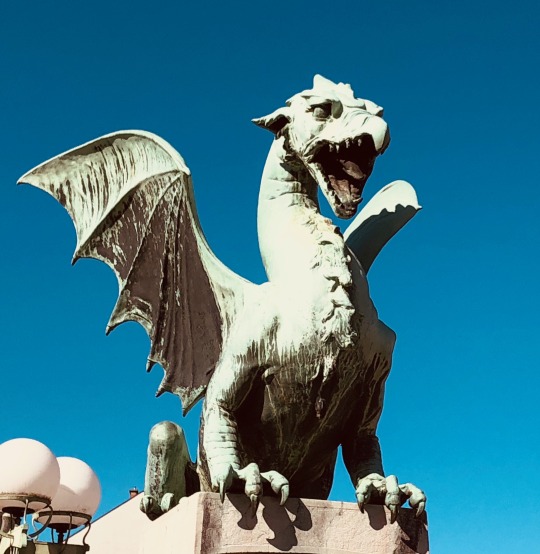




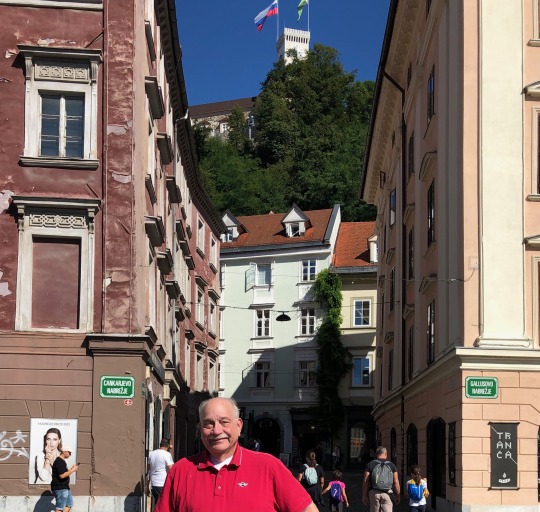


Lake Bled is within the Julian Alps and close to the Austrian and Italian borders. I’ve been told the only island in Slovenia is the small one in the lake with a church on it. A castle commands a high view from one side of the lake. After touring the castle, we were given time to stroll, hike, walk around the lake. That was a serene and beautiful way to see this marvelous place. Actually I did not walk totally around the lake but went about half way to 2/3 in one direction and returned the same way. So, yes, may not have walked all the way around, but covered the same distance. Preferred to stay in woodsy forest setting than ending up in the developed town by the lake. One note, a villa used by Yugoslavian strongman Marshal Tito now is a small hotel.



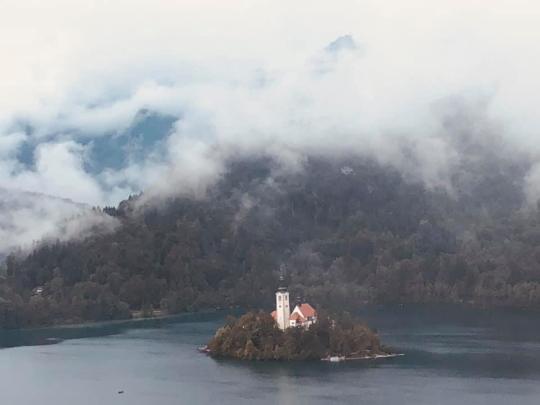
Other highlights of Slovenia is the beautiful vistas driving through the Julian Alps and a stop in the town of Kobarid to see a World War I museum. Several major battles were fought in the area and a young Ernest Hemingway served as an ambulance driver which he later turned into his novel A Farewell to Arms.
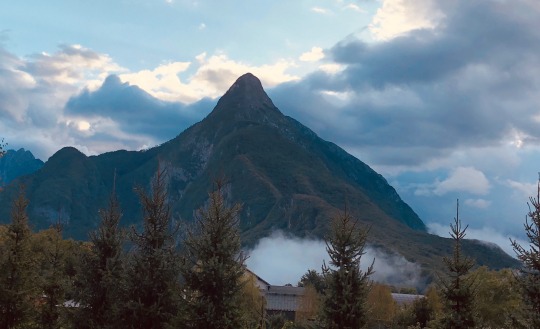
It was during this final stretch in Slovenia that we crossed into and out of Italy in about 30-minutes.
Croatia
The bulk of the two-week tour was in Croatia mainly spending the time along the Adriatic coast from the Istrian Peninsula down to Dubrovnik.
Istrian Peninsula juts out into the Adriatic and is close to Venice and the Italian coast. Supposedly from the town of Rovinj you could see Venice on a clear day. Well they say that but I didn’t. There is a heavy Roman and Venetian influence in the towns we saw including Roman amphitheater in Pula.

Rovinj
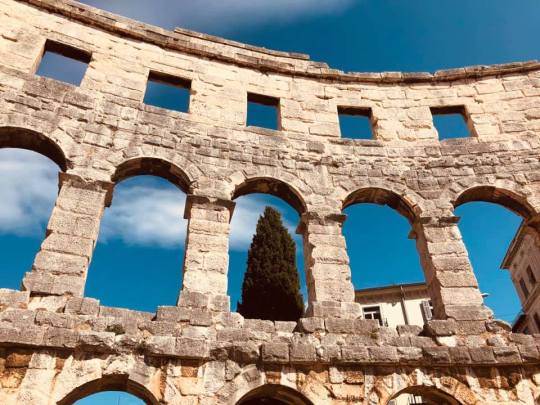
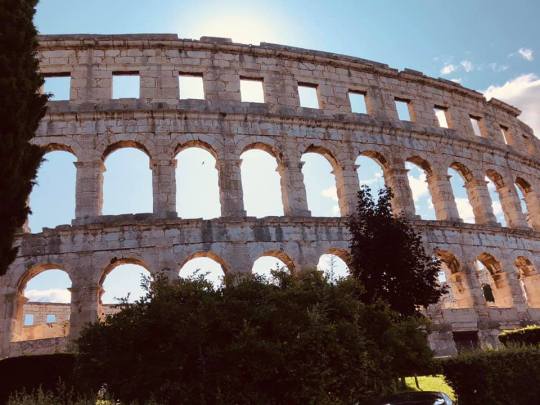

Three from Pula
Venetian influence is seen in Rovinj and Opatiija. As I walked into the warrens of the streets of Rovinj, I felt as if I was walking in Venice or a Tuscan or Umbrian hill town. It was as close to feeling in Italy without being there.


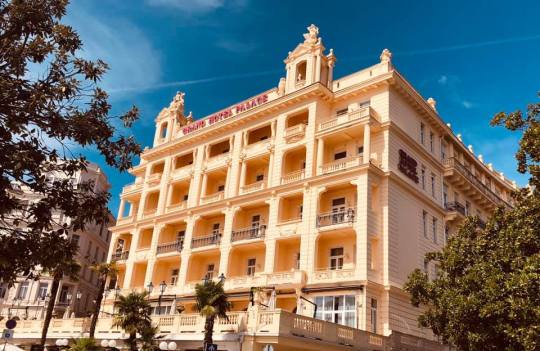
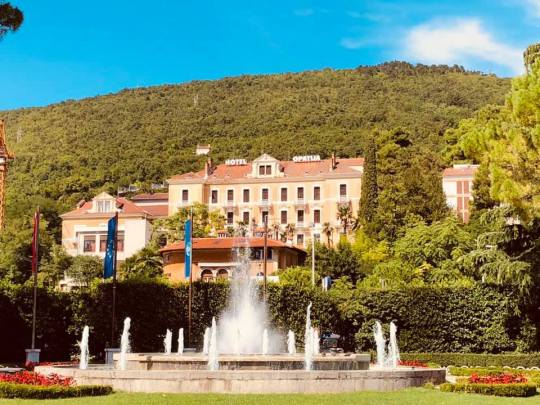

5 photos of Opatija
The interesting note about the Istrian Peninsula is that the towns all have two names, the Croatian name and an Italian name even though it has been centuries since the area was under Roman or Venetian control.
Plitvice Lakes National Park is an absolute jewel. The tour made sure we entered the park early in the morning at one end that is not the usual entrance for tourists. The goal was to walk through the park which is full of lakes and waterfalls until we arrived at the main entrance. It was a six mile, 16,000 steps walk seeing amazing vistas and waterfalls all by noon! I don’t think my photos do it justice. At one point I mentioned to someone I was walking with that it reminded me a bit like Milford Sound in New Zealand. Within minutes heard someone going in the other direction say the same thing.
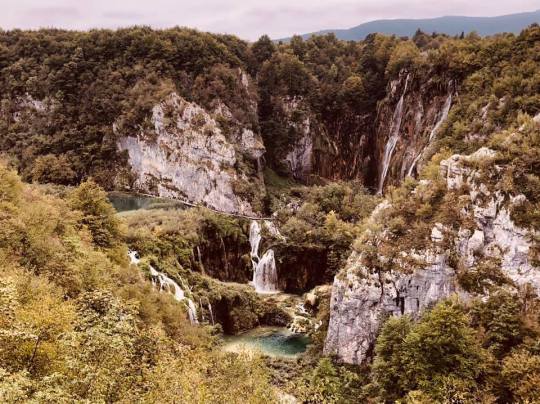
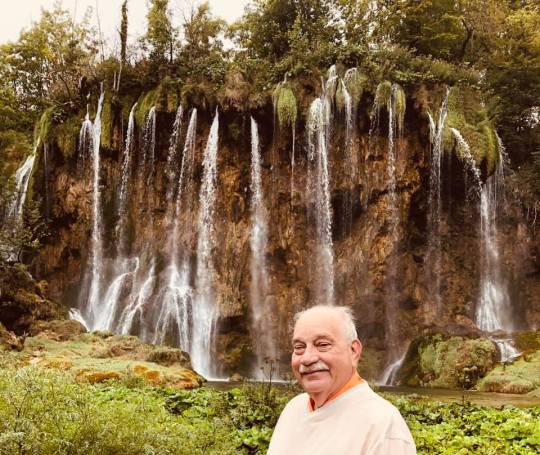
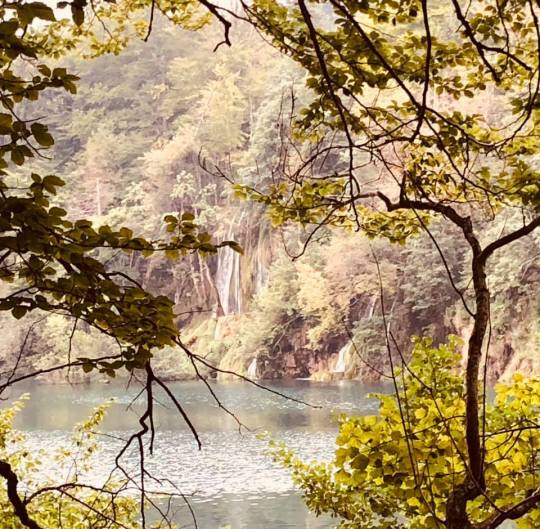


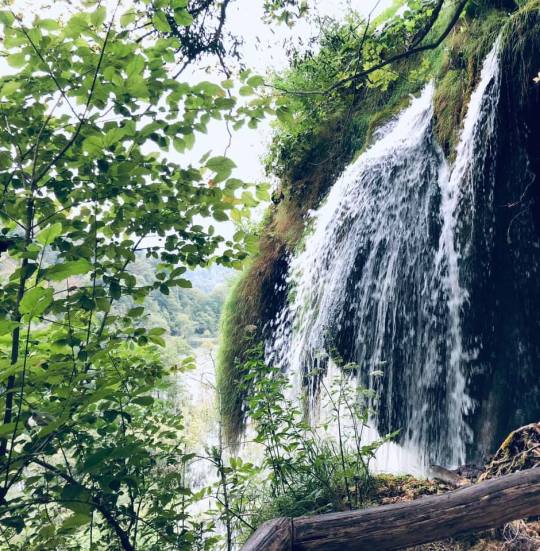
Even though the tour guide was specific about where we should meet near the end of the trail, we lost four women. I later said they saw the walk through the park as a race and not a walk. They were in front of all of us and took the wrong turn near the trail end. While we waited where we were suppose to be, they ended up walking back to where we entered the park! Of course we found them but had to change where we would have lunch since their misadventure forced a change of plans.
Split
One of the jewels of Croatia is Split. An amazing beautiful city nestled on the Adriatic. We spent two nights there (thank goodness, was able to get laundry done) and was absolutely beautiful. Was supposed to meet up with my ex-boss who was going to be there at the same time, but he cancelled on me. So I spent free time walking along the seaside walkway.
The main tourist attraction is the remains of the Roman emperor Diocletian’s palace. The modern city used the remnants as a base to build along the waterfront. One part of the basement of the palace that is intact supposedly was used in the filming of the HBO show “Game of Thrones.”




I was able to find the synagogue in Split which is barely used for services on Saturdays or for holidays.
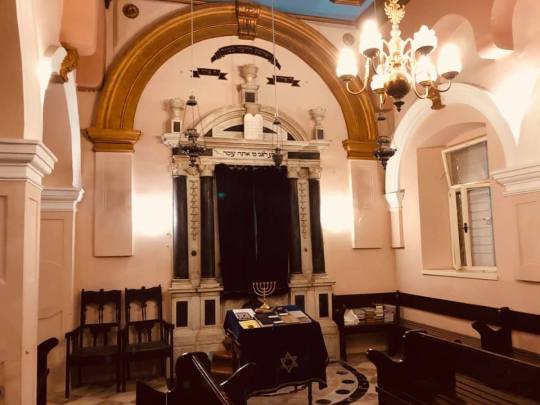


Split is definitely a place I would return to if the opportunity came again.
Korcula
A two-week tour is somewhat exhausting so the last weekend we were given a free day on the island of Korcula. It is off the coast of Croatia between Split and Dubrovnik. To get there we had to take a ferry from the mainland. And we needed the break. Absolutely gorgeous with amazing views of the Adriatic. I had not planned on bringing a bathing suit to go into the sea but if I had to do it over, would have just to get into the Adriatic. As is, I was only able to dip my toes and hands.




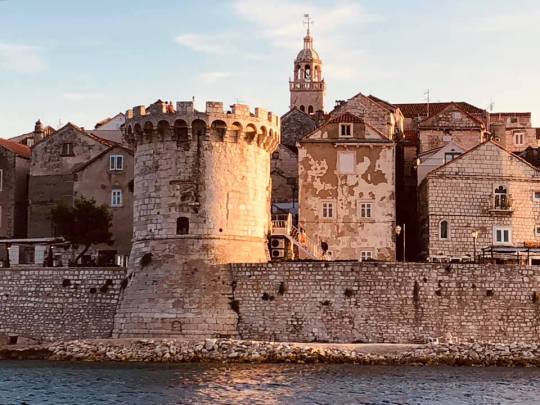

Dubrovnik
The old city is an amazingly beautiful walled city. We were given a walking tour by a local who lives inside the walled city. Luckily we did the tour in the morning beating the crowds from a cruise ship that disgorged hundreds of tourists into the small area of the walled city. Clearly a case of over-tourism. There were more tourists than necessary for us to fully enjoy the scenery.
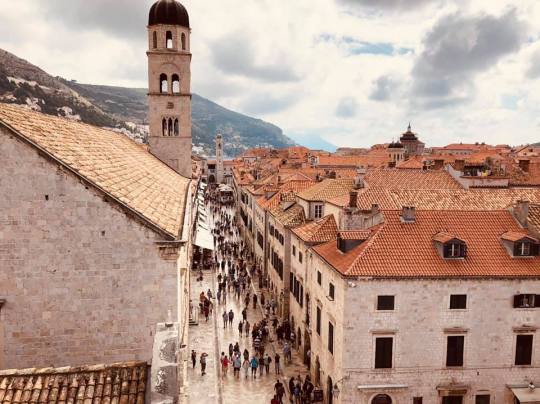

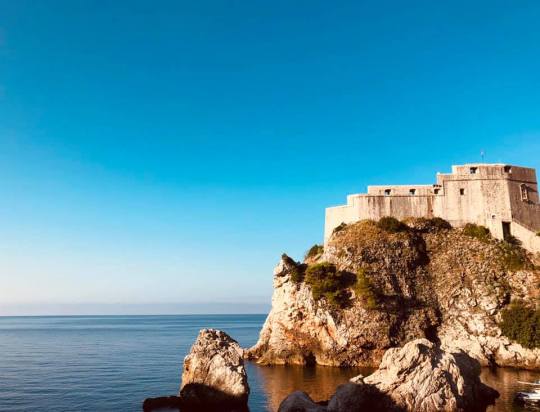
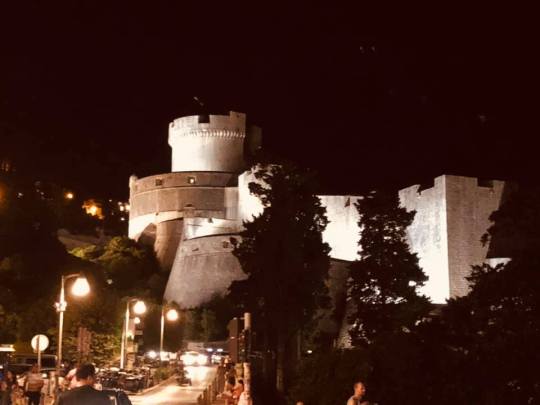

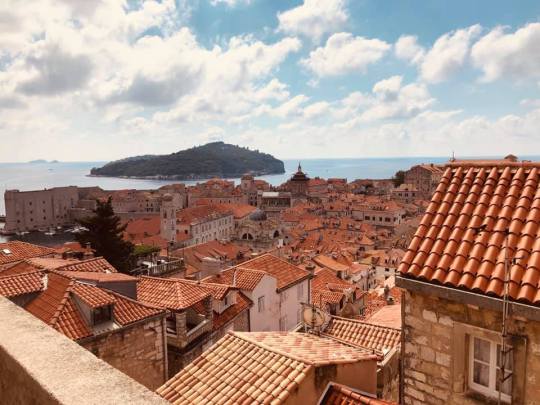
The highlight of the day was walking around the city wall and seeing the city below in its full beauty. And, similar to Split, I was able to go to the synagogue which is now a non-working synagogue.



Bosnia
One of the “Wow moments” of the tour was our overnight trip to Mostar in Bosnia. Mostar sits in a river valley with high hills surrounding the city. It was from those heights that the town was shelled during the siege that devastated it during the wars in the 1990s.
The famous arched old bridge was destroyed - a bridge that was originally built by the Ottomans in the 16th Century. As the area calmed down and peace was relatively restored the bridge was rebuilt and is the main tourist attraction in the old town area. Locals will solicit money before diving off the bridge into the river. The crowds swell to see this sight. And, according to the tour books, so do the pickpockets. Luckily didn’t bother me.




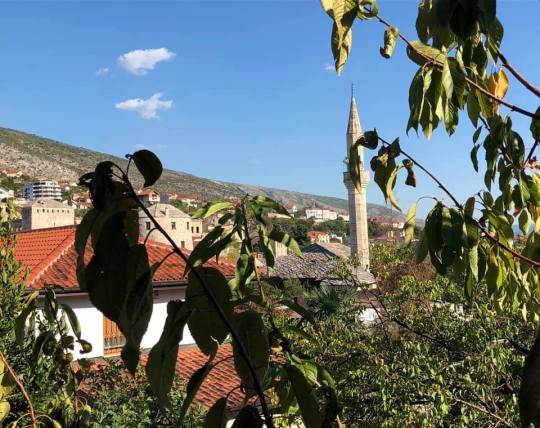
We had a local guide, a Bosnian Muslim who described how she and her family survived the shelling and the siege. At one point when the bridge was destroyed, her family was divided by the river without contact from the other side for weeks. She recalled her brother still has shrapnel from a shelling that also killed her uncle. We saw numerous buildings still with signs of being damaged from the war.
She was not enthusiastic about the peace accord that ended the war. The agreement was brokered by the Clinton Administration and established a couple of autonomous ethnic zones, especially one for Serbians. She felt that has led to a country with multiple presidents and a lack of cohesion as a nation. However so far that agreement has held.
Observations
This was a region of Europe on my “must see” list for some time. Now I can go to other parts of Europe without wondering will I get to the Adriatic area. A member of the tour said to me that it is a tribute to Leila that I continue to travel, something we loved to do together.
Loire Valley and South France in spring 2020 and South Italy in October 2020 coming up.
1 note
·
View note
Text
An Adventure Travel Insiders Information To Heli-skiing In 2021
Most operators provide clients with powder skis and poles. You are expected to convey your personal boots and correct clothes. These four to five-star lodging offer the excessive degree of service that our staff look all the time search for, with a spread of amenities on offer. A very high normal of five-star properties, with top-notch service and a variety of amenities and experiences ensuring an unforgettable stay. Stay in a secluded and modern styled Ryokan amongst the white birch timber of Hanazono Wood in Japan’s North Island. The Zaborin Ryokan was created to embody a up to date experience of Japanese traditions while providing a tranquil and distant setting for guests to meditate and replicate.
The highland has turn into very fashionable among the skiers, stated Tayfun Bekar, head of the Kavrun Highland Culture and Tourism and Conservation Association. Every winter, residents there concern it may occur once Heliskiing more. According to the locals, prior to now, avalanches hit the area each different 20 years however lately these disasters started to occur extra frequently — around two or three years apart.
The day begins with a climate examine, then transport to the staging area. Safety briefings on avalanche transceivers and helicopters are followed by a simple scenic experience Heliskiing to the ridge of your desires. From here it’s all downhill via powder, as you and your guide lay strains on the slopes.
Heliskiing may be very weather dependant, each for flying circumstances on which the pilot has the final say and on snow circumstances significantly on the glaciers. Ever dreamed of taking over an entire heliski lodge along with your closest friends or enjoyable in the peace and quiet of a distant getaway reserved just for you and your family? Contact us to debate a completely customized program and exclusive lodge booking. With our small group format and two devoted A-Star helicopters servicing solely four small teams , this program guarantees an action packed ski journey.
While distinct in character, they each have their very own allure. Over more than two decades, we’ve fastidiously honed our approach to helicopter skiing and boarding. If heli-skiing is in your Heliskiing bucket listing and you need to do it the right means, get in touch. We would be delighted to create an unforgettable experience designed especially for you.
All you want is a helicopter, a pilot and access to normally unreachable snowy mountains. Prices vary greatly depending on yacht type and equipment requirements, and a Patagonian heli-ski superyacht charter can vary wherever from $250,000 to $2 million (£185,000 to £1.48m) per week. On a cloudy February day in 1963, Austrian mountaineer Hans Gmoser ferried a group of skiers in a small Bell forty seven helicopter to the highest of a Canadian peak to start out their day on the slopes. Gmoser actually wasn’t the first to have such an idea, but this pioneering journey in Alberta is mostly thought-about to have marked the beginning of commercialised heli-skiing. By distinction, because of its far north latitude, and proximity to Pacific storms, Northern BC’s Skeena Mountains obtain reams of snow by early December and have a means more dependable early season snowpack. That northern location also means the skiing is still excellent well into April and even beyond.
0 notes